Are you in the market for new bouldering shoes? Whether you’re a beginner looking to size your first pair or an experienced climber seeking a comprehensive sizing guide, finding the right fit can be a challenging process. Sizing climbing shoes is a rite of passage that often involves making mistakes and learning from them.
That’s where this Sizing and Fit guide comes in. Designed to help you overcome this challenge, I’ll share everything I’ve learned about sizing bouldering shoes, including common mistakes and pitfalls to avoid. My mission is to help you find the perfect fit for your needs, so you can focus on your climbing and not your shoes.
5 common mistakes made when sizing bouldering shoes
Mistake #1: Don’t size based on your street shoe size
Bouldering shoes should be sized down from our street shoes, or at least, we keep getting told. This is not the right way to size climbing shoes, because climbing shoes have nothing to do with your street shoes.
Climbers will often say ‘I size X sizes down from my street shoe’. This is a highly misleading concept, especially for beginner climbers who are trying to figure out their climbing shoe size.
The reason this concept is wrong is twofold:
- Manufacturers size climbing shoes differently
- Everyone sizes their street shoes differently
Every manufacturer has a different way of sizing climbing shoes. I’ll explain with my own shoe sizes. I’m a size 38.5 street shoe size with a mondopoint of 240mm (we’ll get to that later).
In La Sportiva, I’m a 36.5 which would be 2 sizes down. In Evolv, I’m a size US 6 which is my exact street shoe size. And in Scarpa, I’m a size 37.5. But If I were to put all these shoes together, they would look the exact same size.
Thus, if I were to go for my street shoe size in Evolv it would have been spot on. But if I had downsized that shoe, my feet wouldn’t have fit. If I sized La Sportiva in my street shoe size, I would have a pair of floppy clown boots.
Lastly, I want to point out that everyone sizes their street shoes differently. I noticed this quite recently, but everyone has different standards for their sneakers. Some people like to fit shoe sizes snugly, while others like it roomy.
That’s why sizing based on your street shoe size, is a dangerous concept. I’ll give you a much better way of sizing further in this article.
Mistake #2: Don’t Size Based On Your Other Climbing Shoes
In Mistake #1 we highlighted that manufacturers size their shoes differently. I’m a 38.5/US 6 in Evolv but a 36.5 in La Sportiva. It would be a terrible idea for me to purchase bouldering shoes online based on the size I have in a different brand.
Mistake #3: Not considering the stretch
Climbing shoes can stretch a fair bit during the break-in period, so it is a big factor to consider. The amount of stretch your shoe will sustain largely depends on the material that is used.
Vegan climbing shoes made from synthetic materials have about 0.5 sizes of stretch in them and should feel pretty good right out of the box.
Non-vegan climbing shoes made from leather materials have up to 2 full sizes of stretch in them and should be pretty painful right out of the box.
Mistake #4: Sizing aggressively as a beginner
Climbing shoes should fit very snugly, especially if you are wearing a pair of performance shoes where an aggressive toe curl is necessary to get the most out of your expensive purchase. But this isn’t something that beginners should worry about.
There’s a progression when it comes to downsizing. Adam Ondra didn’t size down 4 sizes when he started out like he is doing now, it came with time. So you shouldn’t be sizing aggressively either because people are telling you.
Size them to be tight, but not too tight that you don’t want to climb in your new bouldering shoes.
Read also: Should climbing shoes hurt?
Mistake #5: Sizing too comfortably as a beginner
On the other side of the medallion, plenty of beginners size for extreme comfort, only to find their shoes to be too big after a couple of sessions. Your shoes will definitely stretch from their original fit and if you size them like you would a street shoe size, like rental shoes in the gym, or simply for ‘comfort’ you might end up with shoes that are too big after a couple of sessions.
Especially climbing shoes made from leather (like most of La Sportiva’s lineup) are going to stretch a lot.
How tight should bouldering shoes fit
There are three types of bouldering shoes and each are sized differently: beginner, intermediate, and performance shoes.
Beginner Bouldering Shoes fit
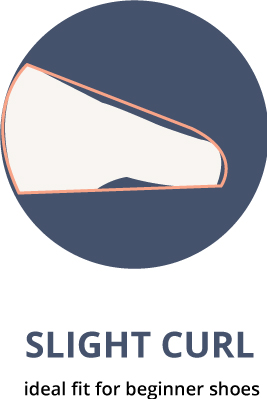
Beginner bouldering shoes should be worn with the toes touching the end and you should have a minor toe curl as depicted in the illustration above.
These beginner shoes are ideal for climbers with 0 – 6 months of experience.
First fit: Keep in mind that they should feel very tight when you first put them on, but they shouldn’t cause any pain.
Intermediate Bouldering Shoes fit
Intermediate bouldering shoes bring comfort and performance together and should be worn with a moderate toe curl. If you stick within the same brand, you might need to size down 0.5-1 size from your beginner shoes to achieve this fit.
Intermediate shoes are ideal for a second purchase, or at least 6+ months of experience. They are the best choice for the largest amount of climbers as they are more comfortable and durable than performance shoes.
First fit: the shoes should feel extremely tight and may cause discomfort.
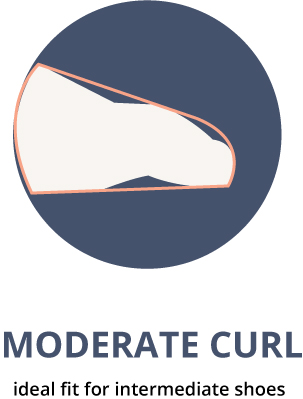
Performance Bouldering Shoes fit
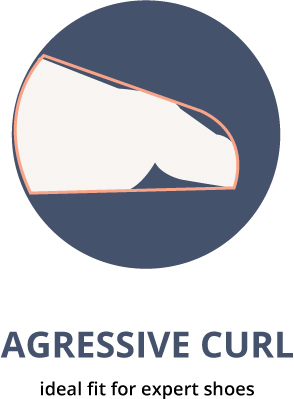
Performance bouldering shoes throw all comfort out of the window in favor of performance. They should be sized with an aggressive toe curl. If you stick within the same brand, you might need to sie down 0.5-1 size from your intermediate shoes.
Performance shoes are painful and shouldn’t be bought as a first or second shoe. At least 12+ months of experience is required to get the most out of these shoes. They are also expensive and less durable than intermediate shoes.
First fit: Should be painful out of the box. If the shoes are made of leather, you may need to use a plastic bag to fit your foot inside for the first couple of sessions before they stretch to a proper fit.
How to size bouldering shoes
Your appropriate size will depend on a range of factors, we’ll go through it step-by-step:
- Pick a brand
- Measure your mondopoint
- Size the shoes
- Figure out how much the shoes will stretch
Step 1: pick a brand
Earlier in the mistake section of this article, I went over how I’m an Evolv 6, La Sportiva 36.5 & Scarpa 37.5. Manufacturers have a different way of sizing their shoes from their competitors, so you should never off your size in another climbing shoe.
The first thing you should do is find the sizing chart for the brand you are eyeing. Luckily for you, I’m generous and have accumulated the sizing charts for you.
- La Sportiva Sizing Chart (PDF)
- Scarpa Sizing Chart (PDF)
- Mad Rock Sizing Chart (PDF)
- Evolv Sizing Chart (PDF)
Step 2: Measure your mondopoint
As you’ll notice in the sizing charts above, they are all measured using mondopoint.
Mondopoint is a universal foot sizing system calculated by measuring the length and width of the foot in millimeters. This system was originally invented with ski boots in mind but can be used to size indoor boulder shoes as well.
Knowing your mondopoint makes sizing climbing shoes infinitely easier. It allows you to use the sizing charts of manufacturers to figure out your ideal size, as opposed to ballparking it based on different brands or your street shoe size.
How to measure your mondopoint
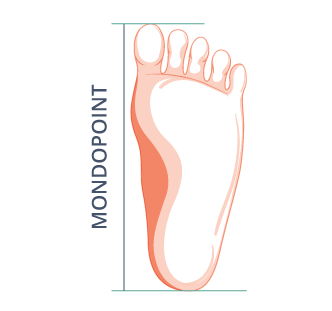
Measuring your mondopoint is very simple, you’ll need a piece of paper (A4), your foot, a pencil, and a ruler.
- Place your foot on top of a piece of paper
- Draw the outline of your foot
- Measure the distance from your big toe to your heel
Repeat for both feet and use your biggest foot measurement as your metric.
Step 3: Size your shoes
Once we have the sizing chart of our preferred brand, and we have our mondopoint measurements, we can use these to find our shoe size.
I’ll walk you through this process using my own measurements.
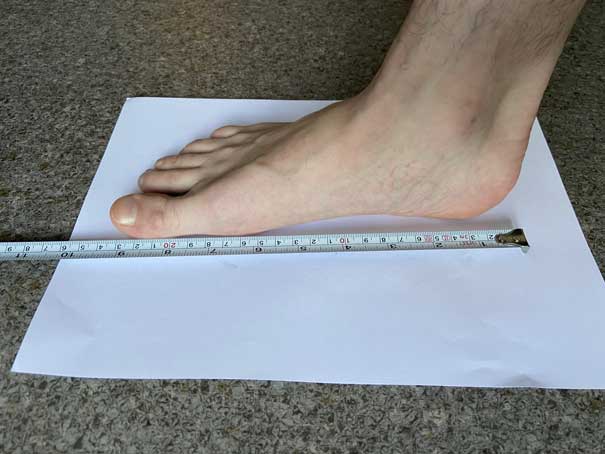
I have a 238mm right foot and a 240mm left foot. I’ll be sizing for my biggest foot.
For this example, I’m in the market for a La Sportiva shoe.
| EU | 33 | 33.5 | 34 | 34.5 | 35 | 35,5 | 36 | 36.5 | 37 | 37.5 | 38 |
|---|---|---|---|---|---|---|---|---|---|---|---|
| Mondopoint (mm) | 210 | 214 | 217 | 221 | 224 | 227 | 230 | 233 | 236 | 240 | 243 |
According to the size chart, my La Sportiva size sits at around 38 EU, which is one full size down from my street shoe size (38.5 EU / US 6).
For a beginner climbing shoe, I would therefore choose a size 38, half a size larger than the La Sportiva sizing chart suggests. 38 Should be a comfortable fit that is still snug enough for a beginner climbing shoe.
For an intermediate climbing shoe, I would opt for size 37.5. This is the exact size that the La Sportiva size chart recommends for your feet. This should accommodate a slight-to-moderate toe curl which is necessary to get the most out of your climbing shoes.
For a performance climbing shoe, I would opt for a size 37. This is half a size down from the suggested size and should be enough for a really tight fit and moderate-to-aggressive toe curl. As you continue to climb in performance shoes you might find yourself sizing down more and more as you get used to tight-fitting shoes.
Once more, below is an illustration showcasing the kind of fit you want to go for.
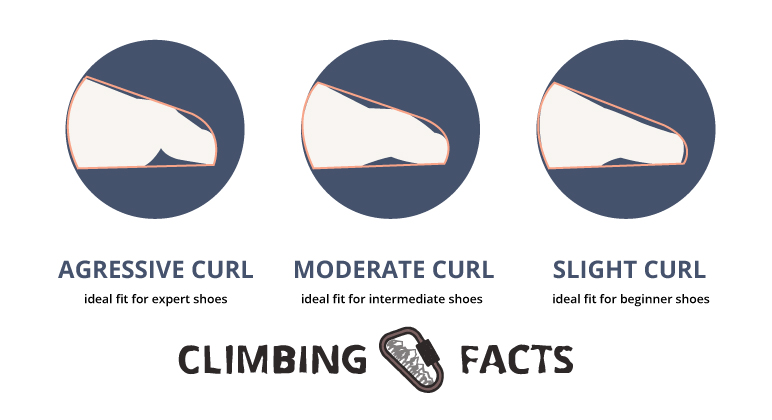
Step 4: How much will they stretch?
Mistake #3 covered the importance of accounting for stretch. Vegan shoes will stretch very little, while leather shoes will stretch quite a lot. So figuring out the material of the upper of the shoe, is an important part of the sizing process.
E.g. I size my La Sportiva Skwama in size 36.5 (half a size down from my usual performance size) because they are made from unlined leather and are known to stretch a lot. With a vegan shoe, I would not have sized down an extra half-size.
If you use any of our Bouldering Shoe Buying Guides, these all include how much the shoe will stretch.
Bonus: my climbing shoes vs my street shoe
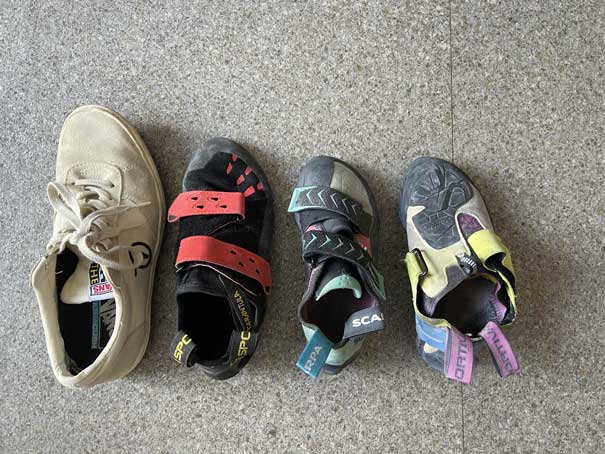
Here’s an example of my street shoe vs some of my climbing shoes.
From left to right we have my street shoe (38.5), La Sportiva Tarantula (beginner shoe: size 38), Scarpa Vapor V (intermediate shoe: size 38), and La Sportiva Skwama (performance shoe: size 36.5).
Bouldering Shoe Sizing & Fit FAQs
Is there a difference in sizing between Bouldering Shoes and Climbing Shoes?
Bouldering shoes are usually sized tighter than climbing shoes since they are worn for shorter periods. If you’re planning to climb a sport route outside repeatedly, it’s better to opt for a slightly more comfortable shoe compared to when bouldering, where you can take off your shoes between each problem.
However, if you’re a beginner when it comes to sizing climbing shoes, this is not something you need to worry about.
How long do Bouldering shoes take to break in?
The break-in period will largely depend on the shoe itself and what it is made of. Vegan climbing shoes break in much faster than non-vegan ones because they are downsized less. Climbing shoes based on leather tend to take longer because they have to be downsized more to accommodate to the stretch.
Do you wear socks in bouldering shoes?
You shouldn’t wear socks in bouldering shoes except for the rental shoes at the gym. Bouldering shoes are soft and meant to be worn tight to get the most sensitivity out of the shoe. If you wear socks in them, you demolish that sensitivity by pushing a thick layer of fabric in between your feet and the shoe.
Wearing socks in beginner shoes is fine but it is advised to step away from this once you start sizing down your shoes to get more feel.
How do I know if my climbing shoes are too big?
The primary indication that your bouldering shoes are too big is that your toes are flat inside the shoes. Your toes should always be slightly curled inside beginner shoes and have a moderate to aggressive curl in intermediate and performance shoes.